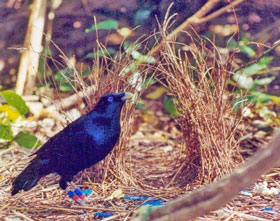

With its glossy dark purple coat, striking pale blue eyes and yellow beak, the male satin bowerbird (Ptilonorhynchus violaceus) could not be called plain, but its plumage nowhere near matches the fantastic feathers of the closely related birds of paradise. Instead of gaudy feathers, bowerbirds as a group use a remarkable method to catch the eye of their brides-to-be. They build trysting places, called bowers, unlike the structures of any other nonhuman animal. Using the bowers as a stage, the birds show off their dancing and singing prowess to admiring females.
Of the 18 bowerbird species, 14 build bowers, ranging from simple to complex. The toothbilled bowerbird clears a patch of forest floor and covers it with painstakingly collected fresh leaves. He lays each leaf with its pale underside uppermost, giving the carpet a light shining appearance in the forest. At the other extreme, the striped gardener bowerbird meticulously clears the base and the ground around a sapling. Then he weaves a layer of twigs around it. This structure, called a Maypole, serves as a centerpiece for his mating dance, and he covers the dance floor with moss and decorations such as shells, feathers and bright leaves. He may even find buttons, bottle caps and other bric-a-brac, all color-matched to his natural trinkets. But the gardener bowerbird hasn’t finished. He tops his dance floor with a domed structure three feet tall and nearly twice that in diameter, then dances around the Maypole inside.

Satin Bowerbird male in front of a bower
© 2004 Seth W. Coleman
10 02 04 On Quirks & Quarks, Bob McDonald interviews Joah Madden, from the department of Zoology at the University of Cambridge on the tendency of Bowerbirds to destroy neighboring bowers. The Quirks page includes links to two other Q&Q stories on Bowerbirds.
Q&Q Bowerbird Bullies
The best-studied of all bowerbirds, the satin, builds a bower between these two extremes. It consists of two parallel fences that look like flattened, vertical haystacks. The promenade between the fences faces the noonday sun (north in Australia) and opens on a dancing platform covered with bright yellow straw. The male satin bowerbird decorates this stage with prized blue parrot feathers, blue and yellow flowers, the shiny wings of cicadas and such other shiny items as he can find. He delineates the boundaries of his stage with larger objects, including land snail shells. He keeps a supply of small objects near the bower to hold in his beak while he dances. The shiny blue objects on the bright yellow background provide a glowing contrast in the dark forest. He enhances this effect by pruning nearby trees to let more sunlight penetrate—all this to attract the attention of a female satin bowerbird.
University of Maryland zoologist Gerald Borgia systematically studied satin bowerbirds partly to determine how female selection might work in this species (see introduction). Female satin bowerbirds examine several bowers in a small territory, using them to assess the qualities of the males maintaining them. Borgia found that building a bower well takes experience. Older males build neater, sturdier bowers and accumulate a greater treasure of blue objects, especially rare blue feathers. They also give more “refined” courtship calls. Getting the blue feathers is no easy task. Because they are extremely rare in the satin bowerbirds’ environment, most birds steal these prizes from other bowers. While stealing trinkets, the marauders may also trash the bower. So protecting and maintaining a bower requires more energy and skill than does building it in the first place.
In addition to recording the activity at bowers on movie film, Borgia manipulated the communication system. He systematically removed ornaments from successful birds’ bowers. These put-upon males attracted fewer mates. When Borgia supplied individually marked blue feathers, he found they ended up in the bowers of the most successful males.
As a result of these exertions, older, more experienced satin bowerbirds may mate with up to 33 females in a season. Each female mates only once, nests in a tree nearby and incubates the eggs alone. Less successful males may not mate at all.